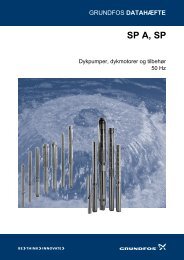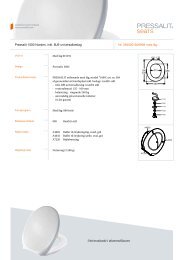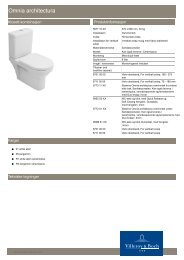Wilo-TOP-E / TOP-ED / TOP-EV - NRF
Wilo-TOP-E / TOP-ED / TOP-EV - NRF
Wilo-TOP-E / TOP-ED / TOP-EV - NRF
You also want an ePaper? Increase the reach of your titles
YUMPU automatically turns print PDFs into web optimized ePapers that Google loves.
– The control systems which can be selected are:<br />
– ∆p-c: The electronics keeps the differential pressure<br />
produced by the pump constant at the differential<br />
pressure set value H S up to the maximum<br />
characteristic curve (Fig. 3).<br />
– ∆p-v: The electronics increases the pump’s<br />
differential pressure set value in a straight line<br />
between H S and 1/2 H S. The differential pressure<br />
set value H increases or decreases in accordance<br />
with the transporting capacity (Fig. 4).<br />
– ∆p-T: The electronics alters the pump’s differential<br />
pressure set value in accordance with the<br />
measured temperature of the medium. This<br />
control system can only be programmed via the<br />
IR monitor (Fig. 5). Only two settings are possible:<br />
– Positive control: The differential pressure is<br />
increased in a straight line between H Smin and<br />
H Smax. as the temperature increases. (Set at the<br />
IR monitor: H Smax. > H Smin).<br />
Can be used, for example, in standard boilers<br />
with a sliding flow temperature.<br />
– Negative control: The differential pressure is<br />
decreased in a straight line between H Smin and<br />
H Smax. as the temperature increases (Set at the<br />
IR monitor: H Smax. < H Smin).<br />
Can be used, for example, in condensing boilers<br />
for which certain minimum condenser<br />
temperatures have to be respected in order to<br />
obtain the optimum degree of heating from the<br />
heating medium. In this case the pump must<br />
be fitted in the return of the installation.<br />
– Regulator mode: The speed of the pump is<br />
kept at a constant level between n min and n max.<br />
(Fig. 6). The regulator mode control system<br />
deactivates the module control.<br />
– With the “auto” control system, the pump is<br />
capable of recognising the minimum requirement<br />
for heat produced by the system by a spontaneous<br />
drop in the temperature of the flow medium and<br />
then of switching to light load mode (light load<br />
curve). The control system is automatically changed<br />
back again should more heating be required.<br />
– The pumps are fitted with an electronic overload<br />
protection system which switches the pump off<br />
should it become overloaded.<br />
– The modules are fitted with a memory to collect and<br />
store data. What this means is that data is stored,<br />
even during long periods of down time. Once power<br />
has been restored, the pump runs again at the same<br />
ENGLISH<br />
values at which it was running prior to the power<br />
cut.<br />
– The module rating plate is to be found in the terminal<br />
box. It contains all data necessary for the<br />
scheduling the unit.<br />
– Pump kick: Pumps switched off using the on/off<br />
switch, the PLR (pump control processor), IR monitor,<br />
or Ext. off start up once every 24 hours for a<br />
short period of time in order to avoid blockages<br />
resulting from long down times.<br />
Should it be foreseen that the power supply will be<br />
switched off for a long period of time, the pump kick<br />
should be taken over by the heating control/boiler<br />
system. In order to do this the pump must be<br />
plugged in (Display → on).<br />
– External Off: (only pumps with P 1max ≥ 500 W, see<br />
rating plate)<br />
The pump can be switched on/off via the external<br />
potential-free contact. Units which are switched on<br />
and off frequently (>20 times a day) can be switched<br />
on and off via “Ext. Off”.<br />
– 0…10 V-input: (only pumps with P 1max ≥ 500 W,<br />
see rating plate)<br />
When the unit is in regulator mode the speed can<br />
be set via an external voltage signal (0…10 V). The<br />
frequency and thus the speed follows the voltage in<br />
accordance with Fig. 6, input resistance: R i ≥ 10 kΩ.<br />
– +24 V output: (only pumps with P1 ≥ 500 W, see<br />
rating plate)<br />
constant-voltage for an external consumer/transmitter.<br />
The +24 V may be loaded with max.<br />
50 mA. The voltage is short circuit-proof.<br />
4.2 Double pump mode<br />
Both pumps are controlled by the master.<br />
Pump fault: The other pump operates according to<br />
the standard control of the master.<br />
– IF(Interface) module: An IF module is necessary for<br />
the communication between the master and slave<br />
pumps, as well as the pump and the PLR (pump<br />
control processor) or interface converter. This module<br />
is fitted on a multiple plug positioned between the<br />
two pumps in the terminal box (Fig. 2). It is available<br />
as an accessory.<br />
– Peak load mode: At partial load, the hydraulic<br />
capacity is provided by one pump only. The second<br />
pump is optimised in terms of efficiency when the<br />
sum of the power requirements P 1 of both pumps<br />
in the partial load range is lower than the power<br />
21







